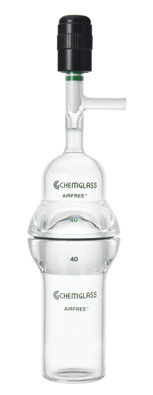



Find all of your laboratory and workplace safety supplies at Safety Emporium!
 Base |
 Glossary Index |
 Biodegradable |
| MSDS Topics |
Free Sites | FAQ's | Regulations | Glossary | Software | Suppliers |
| Books | Forum | Poll | Fun stuff | Quiz | Store | |
| Understand your MSDS with the MS-Demystifier | Search ALL our MSDS info | |||||
Note: The Baumé scale is NOT a temperature scale.
Named for its inventor, Antoine Baumé (1728-1804), the Baumé scale is actually two scales, one for liquids that are more dense (heavier) than water and one for liquids that are less dense (lighter) than water. The hydrometers are calibrated using the following rules:
For liquids heavier than water: 0 °Bé = distance the hydrometer sinks in pure water 15 °Bé = distance the hydrometer sinks in a solution that is 15% sodium chloride (salt, NaCl) by mass. To convert from °Bé to specific gravity at 60 degrees Fahrenheit: specific gravity = 145/(145 - °Bé) |
For liquids lighter than water: 0 °Bé = distance the hydrometer sinks in a solution that is 10% sodium chloride (salt, NaCl) by mass 10 °Bé = distance the hydrometer sinks in pure water. To convert from °Bé to specific gravity at 60 degrees Fahrenheit: specific gravity = 140/(130 + °Bé) |
Remember: you MUST specify whether you are using the "heavy" or "light" scale when stating a Baumé value. The two scales can not be interconverted - they DO NOT overlap. For example, 25 °Bé (heavy) and 25 °Bé (light) are NOT the same!! | |

Get drying apparatus and other organic laboratory equipment and glassware from Safety Emporium!
The Baumé scale does not directly measure the concentration of a solution. For example, to determine the concentration of nitric acid from a hydrometer reading, you would need to determine the specific gravity and then utilize a table of known specific gravity values for nitric acid at known concentrations.
The Baumé scale has traditional usage in industries where hydrometer readings have long been used to indirectly determine the concentration of a solution. Examples include brewing, wine-making, honey production, and acid production. However, hydrometers and pycnometers can also read specific gravity directly, so use that instead of Baumé. It is a LOT less confusing to have only one scale (specific gravity) rather than two similar, confusing and non-overlapping scales (Baumé)!
You may find this term in Section 9 (physical and chemical properties) of Safety Data Sheets for concentrated acids or sugar-containing liquids used by the brewing industry.
We consider the Baumé scale to be archaic (old, outdated) and confusing (because it is really two different scales that do not overlap). We discourage its use anywhere, particularly on SDS's!
By OSHA regulation, the specific gravity is required information on a Safety Data Sheet.
See also: mass units, volume units.
Additional definitions from Google and OneLook.
Entry last updated: Thursday, March 31, 2022. This page is copyright 2000-2025 by ILPI. Unauthorized duplication or posting on other web sites is expressly prohibited. Send suggestions, comments, and new entry desires (include the URL if applicable) to us by email.
Disclaimer: The information contained herein is believed to be true and accurate, however ILPI makes no guarantees concerning the veracity of any statement. Use of any information on this page is at the reader's own risk. ILPI strongly encourages the reader to consult the appropriate local, state and federal agencies concerning the matters discussed herein.